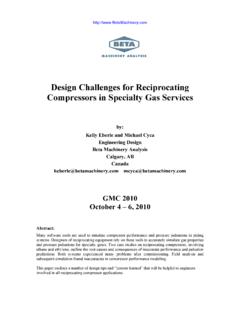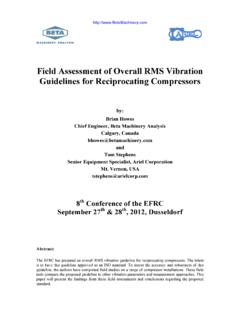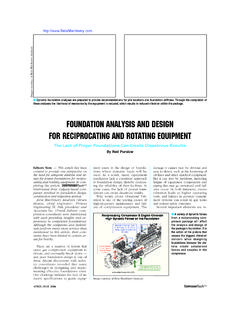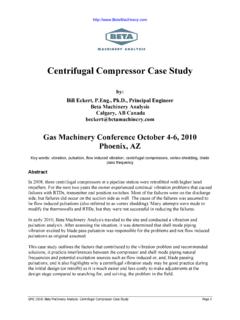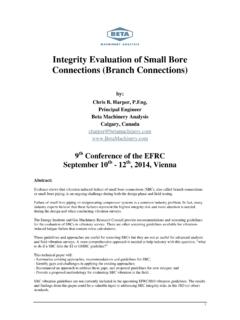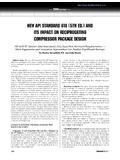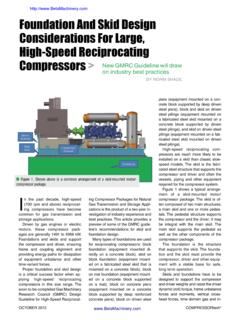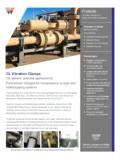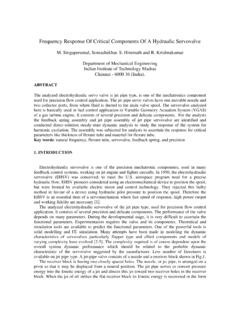Transcription of A Recommended Approach to Piping Flexibility …
1 A Recommended Approach to Piping Flexibility Studies to Avoid Compressor System Integrity Risk by: Kelly Eberle, Beta Machinery analysis Calgary, AB Canada keywords: reciprocating compressor, reciprocating pump, pipe Flexibility , skid edge load, nozzle load GMC 2011 October 2 5, 2011 Abstract: Reciprocating compressors are often packaged on a skid including the Piping , vessels, and other equipment necessary for the particular application. The company packaging the compressor must interface the package pipe connections with the plant yard Piping . The plant yard Piping is often designed by, and the responsibility of, a different engineering company. The interface, or skid edge connection, is the point at which the engineering company and compressor packager define their limit of responsibility.
2 A common industry practice for Piping Flexibility studies is for the packager and yard pipe designer to limit or restrict their analysis to only the Piping within scope of their supply. Limiting the pipe Flexibility analysis at the skid edge connection will limit the accuracy of the analysis . This paper will provide a description of typical design practices as well as the Recommended design Approach for a compressor pipe Flexibility study. GMC 2011: Beta Machinery analysis A Recommended Approach to Piping Flexibility Studies Page 2 1 Introduction Piping Flexibility studies (thermal analyses) are commonly done on Piping systems to ensure the stress , force and deflection due to loads from pressure, temperature, and weight are within safe limits.
3 Different parts of the Piping system may be designed by two different companies. In the case of a reciprocating compressor facility, the compressor packager will be responsible for the Piping and other equipment within the skid or package limits. An engineering company (EC) will typically be responsible for the yard Piping between the compressors and other process equipment such as coolers, coalescing filter and connections to the pipeline (Figure 1). The suction and discharge Piping from the reciprocating compressor package will be connected to the yard Piping at the package skid edge connection. A problem arises for the packager and EC pipe Flexibility analysts as to how to simulate the Piping within their scope considering that there is a shared tie-in or boundary condition at the skid edge.
4 The analyst for the compressor packager is only responsible for the Piping within the package limits up to the skid edge connection. Design of the Piping systems beyond this point is not the compressor packager s responsibility so an Approach for simulating their Piping system is needed. The same is true for the engineering company s Flexibility analysis . Figure 1: Pipe Flexibility Model of a Typical Reciprocating Compressor Installation Consider a smaller part of this system, the 1st stage suction from the shared suction header to the scrubber and suction bottle within the compressor package, as shown in Figure 2. The area of responsibility for the packager and EC is illustrated in Figure 3. The flange set at the connection between these two areas of responsibility is the skid edge connection.
5 The typical Approach specifies that the support near the skid edge connection be an anchor. An allowable load at the skid edge connection anchor point is also specified. The rationale for this Approach is that the skid edge anchor is a means of isolating the Flexibility response of the compressor package and yard Piping from each other. There are several factors that make this Approach inaccurate in a reciprocating compressor service. Also, the resulting design from this Approach will be overly conservative meaning high cost and possibly longer schedule. Five Reciprocating Compressor PacakgesCoolersSuction and Discharge Filters Yard Piping to/from Existing Station Tie-ins GMC 2011: Beta Machinery analysis A Recommended Approach to Piping Flexibility Studies Page 3 Figure 2: 1st Stage Suction Flexibility Model Figure 3: 1st Stage Suction Flexibility Model Showing Area of Responsibility The proposed Approach for the Flexibility analysis in areas where there is shared responsibility for the pipe design is that both parties need to simulate a small part of the Piping that is outside of their analysis (Figure 4).
6 The physics describing how the Piping system will respond due to changes in pressure and temperature does not recognize the arbitrary boundary at the point where responsibility changes. The response of the overall system is calculated accurately and the system design has low cost for materials, construction and installation with the proposed Approach . The Approach is analogous to the building of the tunnel under the English Channel. The French and English contractors each set an end point where the respective tunnels would meet at the project completion. Regular updates on the tunnel progress and deviations due to site conditions are necessary to ensure the tunnels meet at the same point the trajectory of each tunnel is parallel.
7 The overall success of the project relies on both parties making adjustments in their area of responsibility considering factors in the control of the other party. Suction Header and Lateral Packager Scope Engineering Consultant Scope Skid Edge ConnectionSuction Bottle and Scrubber GMC 2011: Beta Machinery analysis A Recommended Approach to Piping Flexibility Studies Page 4 Figure 4: 1st Stage Suction Flexibility Model Showing Area of Responsibility 2 Limitations with Common Design Practices As previously noted, a common design practice for Piping systems where there is a shared responsibility is to split the Piping system into two different models at the skid edge connection (Figure 5). Also, it is often a requirement that the maximum allowable forces and moments be supplied by the compressor packager at the skid edge connection.
8 These allowable loads are then used by the EC for the analysis of the yard Piping . There are limitations to this Approach which can lead to an overly conservative design, which is unnecessary if alternative techniques are used. Following is a discussion of these limitations. Figure 5: 1st Stage Suction System Broken Into 2 Separate Models Compressor Packager Scope Engineering Company Scope Compressor Packager Scope Engineering Company Scope Typical analysis Approach Proposed analysis Approach Anchor at Skid Edge Overlap in Piping analyzed Packager Model EC Model Anchor Anchor GMC 2011: Beta Machinery analysis A Recommended Approach to Piping Flexibility Studies Page 5 Anchor Specification at the Skid Edge Connection The specification of an anchor point in the Piping system (and in the engineer s computer model) is one method to minimize the interaction between the Piping system on either side of the anchor.
9 The practical limitations of fabricating a pipe support that is actually an anchor is very difficult in some cases. A pipe anchor is one where the stiffness of the restraint is orders of magnitude greater than the other pipe restraints installed on the system. For example, process Piping in a non-reciprocating compressor service often has simple pipe rests, guides and limit stops that allow the pipe to move freely in one or more directions. These pipe restraints can be characterized as being flexible. This support design is acceptable since only the forces from temperature changes, pressure and weight need to be considered. Installing a pipe anchor is often possible and practical since the simple restraints on the rest of the Piping are flexible.
10 Adding a pipe anchor that has more stiffness than the simple flexible restraints is easily done. (Figure 6a). Simple pipe restraints such as rests and guides can be used on non-reciprocating compressor Piping since there are no dynamic forces to cause vibration. Pipe restraints such as clamps, straps with wedges or pipe shoes are required on reciprocating compressor Piping systems to minimize vibration from shaking forces caused by pressure pulsations. These pipe restraints have considerably more stiffness than a rest or guide type restraint. Adding an anchor to a pipe system that has clamps and other dynamic pipe restraints will require a large and robust pipe restraint, as well as an equally massive pipe support structure (Figure 6b).
